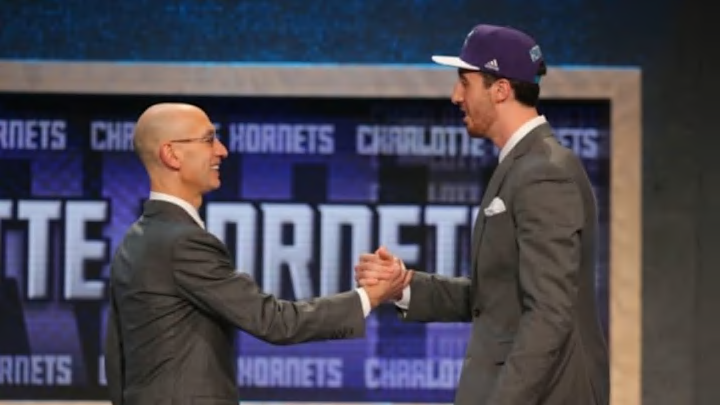
After the draft, reports leaked out that the Charlotte Hornets had turned down an offer of four first round picks from the Boston Celtics, opting instead to keep the ninth pick and use it to select the University of Wisconsin’s Frank Kaminsky. In a piece at Grantland today, Zach Lowe fleshed out some details about the potential deal and Charlotte’s thinking in turning it down:
"The Celtics offered four first-round picks for the chance to move up from no. 16 to no. 9: that 16th pick, no. 15 (acquired in a prearranged contingency deal with the Hawks), one unprotected future Brooklyn pick, and a future first-rounder from either the Grizzlies or Timberwolves, per sources familiar with the talks.Some members of Charlotte’s front office liked the Boston deal, but Michael Jordan, the team’s owner and ultimate decision-maker, preferred Kaminsky to a pile of first-rounders outside the lottery, per several sources. That’s justifiable, if you think your guy at no. 9 has a chance at stardom. The talent gap between no. 9 and no. 15 is real; ask Boston how it felt to squeeze into the playoffs, get demolished by a Cavs team in chill mode, and watch Justise Winslow fall right where it could have picked had it won three fewer games.But Kaminsky is not a star, and the players Charlotte could have grabbed with those four picks will almost certainly produce more combined over their careers than Kaminsky. And the Hornets know they cannot afford to screw up the draft. “Almost every top free agent stays with his current team,” says Curtis Polk, the team’s vice-chairman and a longtime member of Jordan’s inner circle. “The best way for us to build is through the draft.”"
Lowe’s assertion that those four picks will combine for more value than Kaminsky is based on Kevin Pelton’s NBA Draft trade chart. However, it sounds like the Hornets were not necessarily interested in the combined value of four players because they were chasing a star. At a most basic level, it seems like keeping the ninth pick would give the Hornets the best odds of grabbing a star-level player. None of the four picks they were offered were guaranteed to be higher than the ninth pick and the odds of grabbing a star increase exponentially as you get closer to the first pick.
https://twitter.com/VJL_bball/status/572885867204755456/photo/1
However, if we put all the probabilities together, it appears the Hornets may have missed the opportunity to gain a slim advantage.
According to Layne’s model, the ninth pick in the draft has about a 12 percent chance of producing a star quality player. The 15th and 16th picks in this year’s draft that they were offered by the Celtics come in at about eight and seven percent each. The cumulative probability of those picks would then be about 15 percent, slightly more than the probability the Hornets had in keeping their own pick. This doesn’t even take into account the added star-producing probability of the two future first-rounders Boston was offering.
If we look at the specific players involved, things get a little messier. By Layne’s projection system, Kaminsky has about a nine percent chance of hitting a star-level of production. Justise Winslow was still on the board with far higher star-probability–38 percent–but the Hornets were likely swayed by fit, given that they already had a somewhat similar wing in Michael Kidd-Gilchrist. The players actually selected with the 15th and 16th picks–Kelly Oubre Jr. and Terry Rozier–had a combined star-production probability of just seven percent (all from Oubre). The only better proposition with those picks, from a probability standpoint, would have been taking Oubre and Devin Booker for a combined star-probability of 12 percent–the same as what would typically be found with the ninth pick.
We’re dealing with narrow margins in projected probabilities, not definitive expectations. The differences between these different scenarios are small enough as to be negligible. The real key is the two future first rounder. If one or both of those picks were to end up falling in the lottery it would likely definitively push the probabilities in favor of the deal. The Hornets were considering several variables in their decision, but if the goal was to add a star they were probably better off taking the picks.
